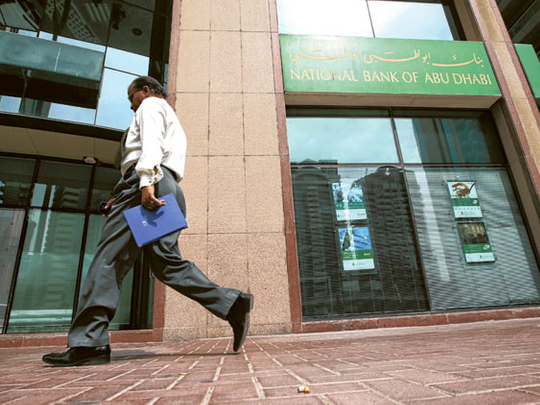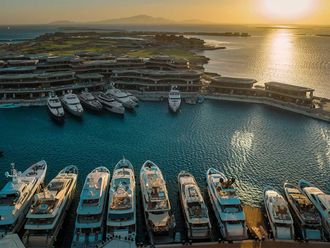
Dubai: The financial crisis of 2008-09 and the preceding boom have left a large share of Gulf banks' loan portfolios impaired. The 2011 third quarter results of regional banks show that even after three years into the global crisis, balance sheets of the region's lenders are saddled with high levels of non-performing loans (NPLs) and profitability is likely to be subdued during the next two years, according to analysts and rating agencies.
Despite such a weak outlook, analysts say, Gulf banks are systemically strong.
"Some of the key financial soundness indicators suggest that banking systems are generally well-capitalised and that provisioning levels are satisfactory. Capital adequacy ratios are in double digits. Loan-loss provisions cover more than 80 per cent of NPLs on average," said George Abed, Institute of International Finance (IIF) Senior Counsellor and Director for the Middle East and Africa.
With NPL ratios exceeding 8 per cent of total assets, banks in Kuwait and the UAE have weaker outlooks than their Gulf peers.
Liquidity worries
Rating agency Moody's has projected a negative outlook for the UAE's banking system because of the ongoing corporate deleveraging, asset quality challenges and the subdued profitability of UAE banks in the wake of continued provisioning needs.
"Moody's negative outlook on the UAE banking system is mainly driven by the legacy asset quality challenges related to the restructuring of some large government-related borrowers," said Khalid Howladar, vice-president and senior credit officer at Moody's Dubai office. After an initial surge in foreign deposits in the UAE banking system in the second quarter of the year following the political upheavals in some Middle East and North African countries, there has been a sharp decline in bank deposits. The overall deposits, which shot to a high of Dh1.128 trillion last April are now down by Dh61 billion, or 5.4 per cent, from that level.
According to data from the UAE Central Bank, money supply growth, an indicator of liquidity, slowed sharply in the third quarter. M2 (broad money excluding government deposits) grew just 6.1 per cent year on year in September, down from 12.5 per cent at the end of June. There was a 2.9 per cent month on month decline in dirham demand deposits in August, and a 2.4 per cent month on month decline in Quasi money (foreign exchange and term deposits) in August as well. In September, cash in circulation declined 7.4 per cent.
"When we compare the developments in the UAE with Saudi Arabia and Qatar, we note that there has been a slowdown in liquidity growth across all three countries in the third quarter. The slowdown appears to have been the sharpest in the UAE," said Khatija Haque, GCC Chief Economist at Emirates NBD.
Credit growth in the UAE continues to lag that of Qatar and Saudi Arabia, where private sector lending growth (year-on-year) was close to 15 per cent and 10 per cent respectively in the first nine months of 2011.
Spending measures
Saudi Arabian banks are lending more as government spending boosted confidence in the country's economy, benefiting the private sector. Ten out of 11 publicly-traded Saudi banks raised the value of their loan portfolios in the first nine months of the year, according to statements from the banks. Alinma Bank, an Islamic lender, had the largest increase at 75 per cent. Bank Al Jazira followed at 19 per cent. Al Rajhi Bank, the largest lender by market value, and Bank Al Bilad had a 12 per cent increase each.
"The Saudi government's additional spending measures, introduced in March this year, are being implemented as planned, and we expect public spending to increase by $44 billion [Dh161.48 billion] in 2011 [equivalent to a 25 per cent increase over the actual spending of the previous year]," said IIF's Abed.
Last week, rating agency Standard & Poor's ranked the Saudi banking system among the safest in the world. The ratings agency gave Saudi Arabia a Banking Industry Country Risk Assessment (BICRA) rating of 2, upgraded from 3, making it the most low-risk banking sector in the Middle East. Qatar and Kuwait have scores of 4 each while the UAE has 5.
Rising funding costs a concern
Dubai: Analysts say a potential spike in funding costs due to the European crisis combined with the absence of Western banks in refinancing some of the maturing debts of government-related entities could increase the non-performing loans (NPLs) and reduce the profitability of local banks.
"In the third quarter, many UAE banks reported healthy profits as result of higher net interest margins. Banks were able to achieve this by switching their high cost deposits with lower cost interbank borrowings. In the longer term funding costs will be a key factor in determining profitability," said Ankur Shah, Director of Equity Research at Arqaam Capital.
Ratings agencies said Abu Dhabi banks are better positioned to expand their loan books and report better profitability. Within the UAE, Abu Dhabi banks have shown a declining trend in NPLs during the first nine months of the year while the UAE banking sector as a whole showed a surge in provisions. According to the latest statistics from the UAE Central Bank, specific provisions made by UAE banks rose 13.8 per cent to Dh50.4 billion, year on year at the close of the third quarter.
In contrast, challenges facing Dubai government-related entities will continue to weigh heavily on Dubai-based banks.












